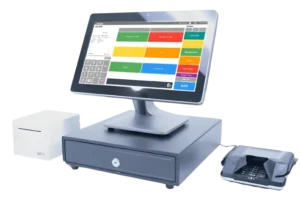In today’s retail landscape, conveniences stores dominate the scene with their accessibility, varied product offerings, and more intimate shopping environments. As businesses adapt to the fast-paced demands of modern consumers, optimizing operations becomes a crucial task. A cornerstone in this strategy is building robust customer loyalty. When customers feel valued and satisfied, they return willingly transforming occasional transactions into consistent patronage. For convenience store operators, cultivating such loyalty can significantly impact overall success that can be accomplished with a convenience store point of sale.

Embracing technology advancements has reshaped how retailers interact with their patrons. Point of Sale (POS) systems stand at the forefront of this evolution, offering an indispensable tool for boosting efficiency and fostering lasting customer relationships. By streamlining purchases through innovative solutions like mobile payments and integrating valuable data for personalized marketing, POS systems provide a foundation on which customer loyalty can thrive. As we delve further into this article, we will explore how investing in these technologies not only enhances operational effectiveness but also paves the way for increased consumer engagement across the convenience store industry.
Understanding POS Systems
A point of sale (POS) system is the backbone of retail operations, facilitating the processing of sales and transactions. In convenience stores, a POS system typically comprises both hardware components, such as cash registers and barcode scanners, and software solutions that manage inventory, sales data, and customer interactions. This combination enables retailers to handle routine transactions efficiently while gaining insights into consumer behaviors and preferences.
Technological advancements have significantly reshaped how convenience stores operate. Traditional cash registers have evolved into sophisticated digital systems that integrate with mobile payments, loyalty programs, and cloud-based services. Today’s modern systems not only allow for quicker checkouts but also support real-time inventory tracking and advanced analytics. Stores like 7-Eleven have incorporated advanced technologies to offer features such as contactless payments and mobile wallet acceptances, highlighting the dynamic shift in retail technology adoption.
The role of a POS system extends beyond transaction processing; it acts as a tool for streamlining operations across multiple facets of store management. By automating inventory tracking and reporting functionalities, POS systems reduce manual errors and free up employee resources for more customer-centric activities. Additionally, they enable seamless coordination between different sections of a business—from stock rooms to storefronts—thus optimizing operational efficiency. Through these capabilities, convenience store point-of-sale systems play an integral part in fostering efficient transactions that redefine the shopping experience while enhancing customer satisfaction.
Speedier Transactions
In today’s fast-paced world, speed is essential in retail, particularly for convenience stores where customers prioritize quick service. Fast checkout processes significantly impact customer satisfaction by reducing wait times and increasing the likelihood of repeat business. A slow checkout process can result in frustrated customers who may choose to shop elsewhere. Quick and efficient checkouts drive satisfaction, leading to more loyal customers and positive word-of-mouth referrals.
Many convenience stores have successfully reduced wait times through the strategic implementation of advanced point-of-sale (POS) systems. For instance, 7-Eleven introduced self-service kiosks equipped with contactless payment options, greatly minimizing transaction time during peak shopping hours. This move not only streamlined their operations but also enhanced overall consumer experience. Another example is Sheetz, which has adopted integrated mobile payment technologies allowing customers to pay via smartphone apps; this expedites the purchase process and keeps queues moving swiftly.
Technologies such as mobile payment solutions have been pivotal in facilitating quicker transactions at convenience stores. Apple Pay and Google Wallet exemplify how digital wallets can seamlessly integrate with POS systems for speedy checkouts. These technologies enable personalized service by automatically incorporating loyalty programs into the transaction without requiring additional effort from the cashier or customer. As a result, interactions are smoother, fringed with efficiency that enhances the shopping experience and fosters stronger brand loyalty among consumers seeking both immediacy and personalized service in their daily errands.
Personalized Customer Experiences
In the competitive world of retail, personalization stands as a powerful tool to boost customer loyalty. Understanding individual preferences helps convenience stores differentiate themselves and engage more deeply with consumers. Tailored shopping experiences can turn a one-time visitor into a regular patron. When customers feel recognized and valued, they are more likely to return, fostering long-term loyalty.
Convenience store point of sale systems play a pivotal role in capturing valuable data that drive personalized marketing efforts. Each transaction offers insight into purchasing habits which can be leveraged to send targeted promotions or recommend products. For example, if POS data indicates a customer frequently buys beverages on their morning commute, stores can offer tailored discounts on breakfast items or suggest complementary products through digital channels. This kind of consumer engagement not only makes the customer feel seen but also incentivizes further spending.
One shining example is the success story of ABC Convenience Stores, which used POS-driven analytics to create custom discount offers for different demographic segments. They noticed an uptick in sales when customers received deals tailored to their unique shopping patterns—effectively increasing repeat business by 25%. By utilizing POS data effectively, stores can transform mundane transactions into meaningful interactions that resonate with individual shoppers and foster enduring brand loyalty.
Loyalty Programs Integration
Integrating loyalty programs with modern Point of Sale (POS) systems creates a dynamic synergy that helps convenience store operators enhance the checkout experience and expand customer retention. POS systems serve as a central hub for transactions, generating valuable data that can be utilized to build more effective and engaging loyalty programs. By linking these systems together, stores can automatically track customer purchases, reward points, and redemption histories seamlessly. This integration not only simplifies the process for both staff and customers but also encourages repeat visits by providing timely rewards that customers value.
Data collection through POS transactions allows retailers to gain insights into their customers’ preferences and behaviors. With access to this information, store owners can design targeted promotions that resonate with their audience. For example, identifying bestselling items during specific times can lead to exclusive discounts or special offers tailored to those products. A renowned convenience store chain in Florida harnessed their POS collected data effectively by launching targeted fuel discount campaigns that coincided with weekend travel trends, significantly boosting customer traffic during those periods.
Several successful case studies highlight the benefits of integrating loyalty programs with POS systems within the convenience store industry. One significant example is Quick Mart’s membership-driven model in Texas. After incorporating their POS data into the loyalty program framework, Quick Mart saw a 25% increase in member participation within six months. Their ability to deliver personalized promotions based on purchase history meant frequent shoppers rewarded immediately upon reaching set thresholds throughout various categories—enhancing customer satisfaction and encouraging continued patronage. This success underpins the potential for other retailers aiming to elevate their own checkout experience while simultaneously building stronger connections with their audience through smart utilization of integrated technologies.
Employee Training and Engagement
Training staff on new convenience store point of sale systems is crucial for maintaining operational efficiency. Proper training not only familiarizes employees with payment technology but also empowers them to handle transactions quickly and accurately. Retailers must invest in comprehensive POS training programs that cover all aspects of system usage, from basic operations to advanced troubleshooting. Employers should conduct regular refresher courses to ensure employees stay updated on the latest features and best practices. This proactive approach minimizes errors, reduces customer wait times, and ultimately enhances the overall shopping experience.
To boost employee performance at checkout areas, retailers can implement a variety of strategies. Gamification techniques, such as awarding points or incentives for speedy service and accurate transaction handling, can motivate employees to excel in their roles. Rotational job assignments allowing staff members to gather experience across different store functions can lead to heightened job satisfaction and a stronger sense of belonging. Additionally, scheduling regular feedback sessions helps identify areas for improvement while recognizing hard work and achievements reinforces positive behavior.
Engaged employees play a pivotal role in driving customer satisfaction. When staff members are confident in using POS technology, they are more likely to interact positively with customers—offering assistance and resolving issues swiftly. In an industry where speed and service quality heavily influence consumer decisions, engaged employees act as brand ambassadors who foster lasting relationships with customers through attentive service and personalized engagement. Therefore, investing in employee training and fostering engagement is an effective pathway for retailers aiming to achieve higher levels of customer loyalty.

Real-World Success Stories
Improved point of sale (POS) systems have proven to be game changers for many convenience stores seeking to boost revenue and customer loyalty. A prime example is a Midwestern convenience store chain that integrated mobile payment options into its POS system. By doing so, they significantly reduced checkout times, which enhanced overall customer satisfaction. As a result, the chain experienced a 15% increase in repeat customers within the first year and saw sales rise by an equivalent percentage. Their seamless blending of technology and convenience set a benchmark for retailers aiming to modernize their operations with cutting-edge POS solutions.
Key takeaways from such success stories underline the necessity of continuously evolving with technological trends while maintaining simplicity in transactions. One fundamental strategy involves leveraging data collected through upgraded POS systems to create tailored marketing promotions. Another successful strategy is ensuring that all elements of the setup—data analytics, inventory management, and transaction processing—support a consistent customer experience. Retailers who capitalize on these areas discover an invaluable opportunity to build deeper connections with their customers.
Lessons learned highlight critical points for other retailers considering similar upgrades. The integration of digital solutions like mobile payments must be executed without removing intuitive user experience elements any existing system offers. It’s essential to provide robust training to employees as new tools are introduced so that front-line staff can maximize efficiency and deliver superior service from day one. Furthermore, businesses should remain adaptive; regularly assessing feedback enables adjustments that optimize both technical functionality and customer engagement. Armed with these insights, retailers can position themselves to harness the full potential of advanced POS systems successfully.
Challenges and Solutions
Upgrading a convenience store point of sale system can present several challenges that retailers must address to ensure a successful transition. One common obstacle is the compatibility with existing hardware and software. Convenience stores may have aging systems that require significant updates or replacements, leading to potential disruptions in operations. Additionally, inventory management integration can become complex if the new POS system does not seamlessly align with current processes. These technical hurdles must be carefully navigated to avoid operational downtime and data loss.

To overcome resistance to change within staff or management teams, communication is crucial. Store owners should clearly outline the benefits of upgrading the POS systems, such as improved efficiency in inventory management and faster billing processes. Encouraging staff participation in training sessions can also help mitigate anxiety about new technology. It is essential for team members to feel confident in using updated systems so they can assist customers effectively during transitions. Incentive programs that reward employees for successfully adapting to new POS technologies can further promote engagement.
Implementing step-by-step transition strategies ensures smooth upgrades. Retailers might consider rolling out new POS features incrementally before full implementation across all stores. This phased approach allows time for addressing unforeseen complications without stalling entire operations. For example, starting with mobile payment solutions could gradually introduce staff and customers to updated systems while maintaining service consistency through traditional methods initially retained for backup purposes. A well-planned strategy minimizes disruption and fosters acceptance among users by demonstrating tangible improvements throughout the process.
Future Trends in Convenience Store POS Technology
Convenience stores stand on the brink of a technological revolution with emerging trends reshaping their operational landscapes. Artificial intelligence (AI) is paving the way for smarter and more efficient POS systems. By leveraging AI, retailers can process data in real-time to optimize inventory management and predict purchasing patterns, leading to better customer experiences. Furthermore, contactless payments are rapidly gaining traction, offering customers a faster checkout process while enhancing security through encrypted transactions.
These advancements hold great potential for boosting customer loyalty. With AI-driven analytics, convenience stores can deliver highly personalized shopping experiences. For instance, stores could recognize customers upon entry and tailor promotions based on past purchases or preferences demonstrated during previous visits. Contactless payment options also improve the overall shopping experience by significantly reducing transaction times and minimizing physical interactions—factors that are particularly valued in today’s fast-paced environment.
The adoption of these technologies will not only enhance individual store performance but also have broader implications for retail industry dynamics. As convenience stores evolve into tech-savvy hubs, competition among retailers to offer superior digital experiences is likely to intensify. This ongoing transformation encourages businesses to invest aggressively in cutting-edge technology solutions as part of their strategic growth plans—ensuring they remain relevant amidst rapid changes. Overall, case studies from early adopters can provide invaluable insights into best practices for integrating advanced POS technologies effectively within various retail settings.
Embrace the Future of Loyalty with POS Systems
Point-of-sale systems have a transformative impact on customer loyalty in convenience stores. Speedier transactions and personalized experiences redefine how stores engage with customers. When aligned with robust loyalty programs, these technologies provide valuable insights for targeted promotions. Employee training enhances performance, ensuring efficient use of these solutions. Real-world success stories affirm that upgraded POS systems lead to increased revenue and strengthened customer relationships.
Investing in efficient point-of-sale solutions drives sustained growth for retailers. These systems offer more than transactional efficiency; they foster meaningful connections with customers through customization and engagement. We urge retailers to seize technological advancements in POS systems as a strategic move towards future-proofing their businesses and cultivating deeper loyalty among customers.
Working with United Banc Card of TN
If you find yourself wanting to conquer your restaurant, retail shop, look no further than United Banc Card of TN. With their innovative solutions and trusted POS System services, they will guide you towards financial success. Whether you are a small business owner or an individual looking to manage your finances better, United Banc Card of TN has the tools and expertise to help. Call us today @615-476-0255

